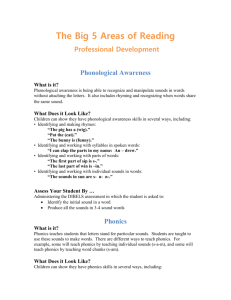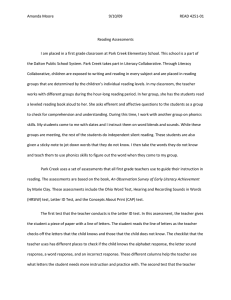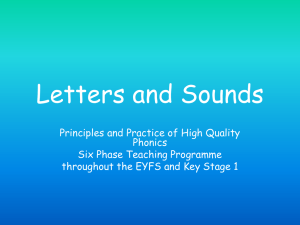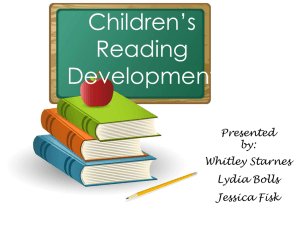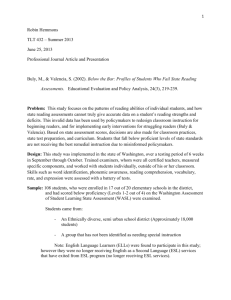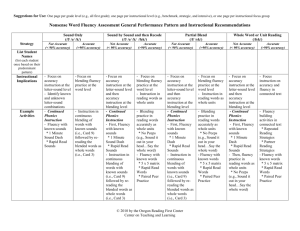Question #1 - WordPress.com
advertisement
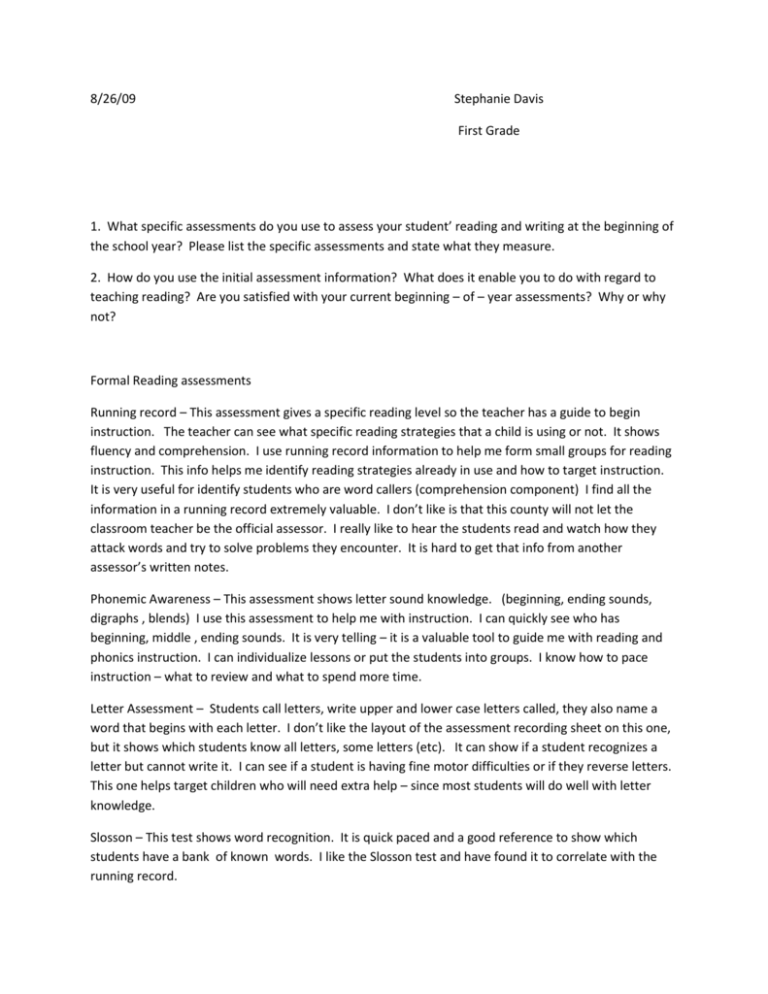
8/26/09 Stephanie Davis First Grade 1. What specific assessments do you use to assess your student’ reading and writing at the beginning of the school year? Please list the specific assessments and state what they measure. 2. How do you use the initial assessment information? What does it enable you to do with regard to teaching reading? Are you satisfied with your current beginning – of – year assessments? Why or why not? Formal Reading assessments Running record – This assessment gives a specific reading level so the teacher has a guide to begin instruction. The teacher can see what specific reading strategies that a child is using or not. It shows fluency and comprehension. I use running record information to help me form small groups for reading instruction. This info helps me identify reading strategies already in use and how to target instruction. It is very useful for identify students who are word callers (comprehension component) I find all the information in a running record extremely valuable. I don’t like is that this county will not let the classroom teacher be the official assessor. I really like to hear the students read and watch how they attack words and try to solve problems they encounter. It is hard to get that info from another assessor’s written notes. Phonemic Awareness – This assessment shows letter sound knowledge. (beginning, ending sounds, digraphs , blends) I use this assessment to help me with instruction. I can quickly see who has beginning, middle , ending sounds. It is very telling – it is a valuable tool to guide me with reading and phonics instruction. I can individualize lessons or put the students into groups. I know how to pace instruction – what to review and what to spend more time. Letter Assessment – Students call letters, write upper and lower case letters called, they also name a word that begins with each letter. I don’t like the layout of the assessment recording sheet on this one, but it shows which students know all letters, some letters (etc). It can show if a student recognizes a letter but cannot write it. I can see if a student is having fine motor difficulties or if they reverse letters. This one helps target children who will need extra help – since most students will do well with letter knowledge. Slosson – This test shows word recognition. It is quick paced and a good reference to show which students have a bank of known words. I like the Slosson test and have found it to correlate with the running record. Informal Reading assessments Nightly reading homework – I have a student reread a home reader. I note strategies used, fluency, tracking skills, decoding/blending, memorization, use of picture clues. I take notes throughout the year to note growth. Self selected reading - At the beginning of the year this helps me to see what kind of books the students are interested in (fiction, nonfiction) or if they are even interested in reading. I look for the same info as I stated above. This time really allows me insight because the stories they read in class will be “new”, not read with someone at home, this can be an eye opener. I walk around and take notes, listen to readers and often wonder why students pick books that are way too hard for them. Read aloud stories, at the beginning of the year, clue me into comprehension abilities. I can see right off the bat – who gets it! I can identify students who are less confident, just observers and the over zealous participators. I think each one of these formal and informal assessments are puzzle pieces that I can put together to get the whole picture. They are all valuable in helping me target skills and I can determine what needs to be done in small group or whole group (or both). I can also communicate to special teachers. Assessment drives instruction. Writing Formal We use the state of North Carolina writing stages rubric. A child is given a writing prompt . They write on the topic without any guidance. This assessment shows what stage of writing a child is in. I can gather lots of information from this baseline writing piece. Does a student write on topic, can he/she include details, varied sentence patterns, along with phonetic and formal spelling abilities. I don’t like the scoring rubric that our county created. It is hard to follow. It would be more helpful to have a checklist of skills in each stage to date when mastered. Informal Daily journal writing -At the beginning of the year, I am using daily journal writing to see the above things along with independence . #3 – Based on your past teaching experience, consider tow groups of students – a low group and an average group. Where do you expect each group to be performing by the end of the school year – in contextual reading and in phonics? Low group – Beginning of the year Even in this group, I find a wide range of struggles and abilities. They are usually early emergent/emergent. Most students in this group know (recognize most alphabet letters. They are familiar with most letter sounds, except for x, qu, w, y, u . They have been exposed to short vowel sounds informally, they know a says a but not that it is short. They always struggle with short a, I, e – not in isolation, but attacking words in stories. They have trouble with decoding and blending skills. They don’t have knowledge of blends, long vowel patterns etc. They don’t really come in with any reading strategies. They may use picture clues to help - but everything is teacher guided. My true goal for these students is to help them acquire different reading strategies so that they can read with confidence. I know that this will be key to help with continued growth. I want all of these students to be solid with letter knowledge and sounds, by the end of first grade. They should be well able to read CVC words and know all short vowels. I would hope that a struggling reader, coming in at B & P awareness or level ½ would make it to level 9/10. Some go well beyond this level some only make it to 7/8. Average group – Beginning of the year Usually, these students come in reading at a 5/6 or 7/8. They know all letters and most sounds , with the exception of y, u, v, w, x, qu. Their automaticity with letter sounds helps them pick up decoding and blending quicker – which in turn leads to usage of other strategies sooner. I expect that these children will be on or beyond grade level (15.16) with the right reading instruction. Sometimes, in this group, I find a student who begins to struggle with fluency or who does not use reading strategies as effectively as the others in the group. I also see students who fly! I could really relate to the teacher in the article that we had to read – her students were all over the map. Students come in with a wide range of skills and abilities.


